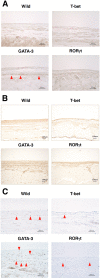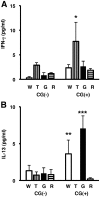Th2-biased GATA-3 transgenic mice developed severe experimental peritoneal fibrosis compared with Th1-biased T-bet and Th17-biased RORγt transgenic mice
- PMID: 26156402
- PMCID: PMC4637371
- DOI: 10.1538/expanim.15-0019
Th2-biased GATA-3 transgenic mice developed severe experimental peritoneal fibrosis compared with Th1-biased T-bet and Th17-biased RORγt transgenic mice
Abstract
Encapsulating peritoneal sclerosis is one of the most serious complications of long-term peritoneal dialysis. The pathogenesis of encapsulating peritoneal sclerosis has not been elucidated, but several putative factors necessary for the development of peritoneum fibrosis (PF) have been reported. However, the roles of T helper (Th) cells in the progression of PF are unknown. The purpose of this study was to clarify the roles of Th1, Th2, and Th17 cells in the progression of PF. T-bet, GATA-3, and RORγt are Th1, Th2, and Th17 lineage commitment transcription factors, respectively. We previously generated Th1-biased (T-bet transgenic (Tg)) mice, Th2-biased (GATA-3 Tg) mice, and Th17-biased (RORγt Tg) mice. In this study, Th1, Th2, Th17-biased, and wild-type mice were administered chlorhexidine gluconate (CG) intraperitoneally and analyzed on day 21. CG-injected GATA-3 Tg mice showed a distended intestinal tract and developed marked thickening of the submesothelial space compared with the other groups. CG-injected GATA-3 Tg mice also showed significant expression of α-SMA positive cells, macrophages, and collagen III in the submesothelium. In contrast, CG-injected T-bet Tg mice only developed mild peritoneal fibrosis. Cytokines analysis in peritoneal fluid showed that IFN-γ was significantly increased in CG-injected T-bet Tg mice and that IL-13 was significantly increased in CG-injected GATA-3 Tg mice. Moreover, intraperitoneal administration of IFN-γ improved PF in GC-injected wild-type mice. Our results suggest that Th2 cells may play roles in the development of experimental PF and that Th1 cells may alleviate the severity of experimental PF.
Figures






References
-
- Ano S., Morishima Y., Ishii Y., Yoh K., Yageta Y., Ohtsuka S., Matsuyama M., Kawaguchi M., Takahashi S., Hizawa N.2013. Transcription factors GATA-3 and RORγt are important for determining the phenotype of allergic airway inflammation in a murine model of asthma. J. Immunol. 190: 1056–1065. doi: 10.4049/jimmunol.1202386 - DOI - PubMed
Publication types
MeSH terms
Substances
LinkOut - more resources
Full Text Sources
Other Literature Sources
Miscellaneous

